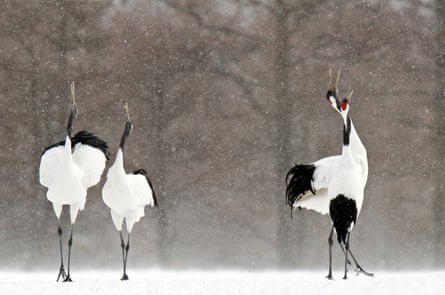The world’s birds have begun flocking towards the earth’s north and south poles and upwards to higher ground as climate change begins to transform their habitats, a new report has found.
One quarter of 570 bird species studied globally have been affected negatively by climate change, while 13% have responded positively, says the study by Birdlife International.
Tris Allinson, one of the paper’s authors, told the Guardian: “People regard climate change as something on the horizon and about to happen but the signals from birds are that significant and profound changes are already occurring, with detrimental effects for a large proportion of the birds studied.”
“We are seeing a consistent pattern of birds moving towards the north and south poles in their respective hemispheres, and moving to higher altitudes on mountain slopes,” he added.

Traditional lowland species, such as Keel-billed toucans (Ramphastos sulfuratus), are now being found at elevations of up to 1,500m in Costa Rica, due to climate change. Grey jays (Perisoreus canadensis) have shifted their range northwards by an average 18.5km in the last 26 years.
One key trend involves ‘warm-adapted’ species becoming increasingly common in Europe while ‘cool-adapted’ animals experience dramatic declines.
Populations of much-loved animals such as Atlantic puffins and Adelie penguins have both plummeted by 50% in just a few generations.
“We are also seeing changes in birds’ behaviour and in the timing of their migrations, which have knock on effects such as mismatches in their interactions with other species,” Allinson said.
Cuckoos, for example, normally time their annual returns from Africa to make use of nests built by local birds, which then rear their young. As temperatures warm, cuckoos have brought forward their trips, but they are still arriving later than local birds are breeding. Cuckoo populations are now declining in several countries.
Birdlife’s paper, The Messengers, predicts that most bird species will experience shrinking ranges, disrupted breeding seasons, and many are likely to shift their population distributions too slowly to cope with the onset of climate change.
The threat of extinctions and population declines is set to rise rapidly as a result. A third of Europe’s birdlife is already considered endangered.
The majority of North American birds are projected to lose over half their current geographic range by the century’s end while birds in parts of east Africa will lose all their suitable habitats.
Deforestation and sea level rise will likely compound the problem, destroying wetland and forests habitats, while malaria-free habitats are poised to increase dramatically.

But the report also signals some cause for hope, with successful examples of the restoration of peatlands in eastern Europe and the creation of migratory corridors in the Red Sea region, allowing 1.5m soaring birds safe passage between pylons, electricity cables and wind turbines.
‘Stepping stones’ between fragmented environments and reforestation could also help ensure the future of the world’s aviators, Birdlife says, along with environmental safeguards for bioenergy and conservation laws and planning.
“Nature has a vital role to play in tackling climate change, but it’s often ignored,” said Edward Perry, another of the report’s authors. “Nature-based solutions not only offer an effective and accessible response to climate change: they also deliver a series of benefits to people and biodiversity.”

Comments (…)
Sign in or create your Guardian account to join the discussion